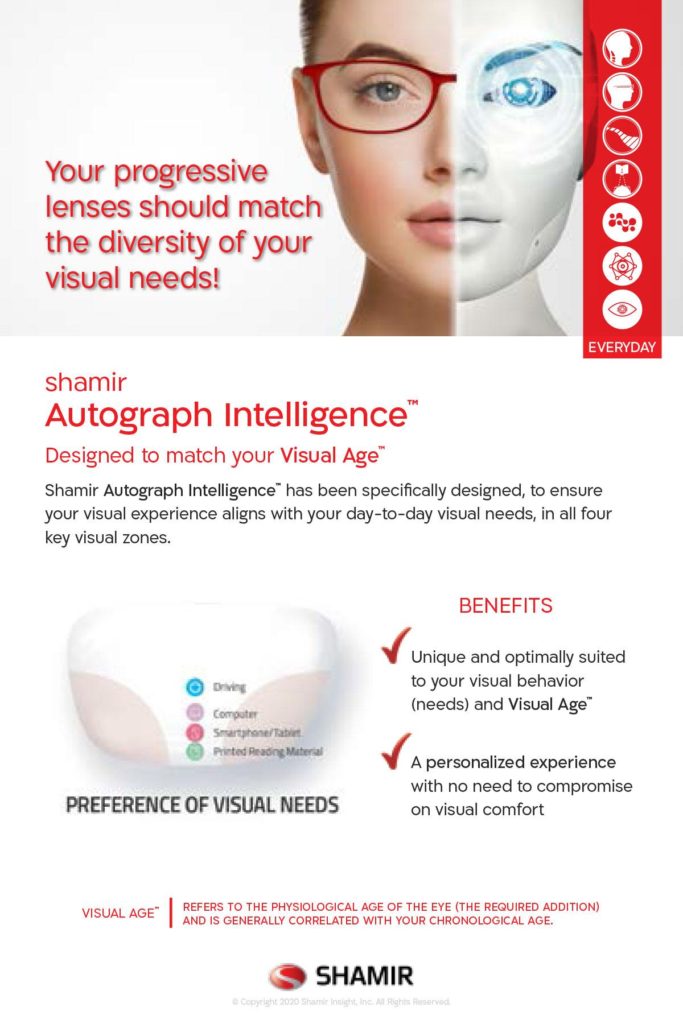Why choosing the right eyeglass lenses is so important
When buying eyeglasses, the frame you choose is important to both your appearance and your comfort when wearing glasses. But the eyeglass lenses you choose influence four factors: appearance, comfort, vision and safety.
A common mistake people often make when buying eyeglasses is not spending enough time considering their choices of eyeglass lens materials, designs and coatings.
Eyeglass Lens Materials – Features and Benefits
Glass lenses
In the early days of vision correction, all eyeglass lenses were made of glass.
Although glass lenses offer exceptional optics, they are heavy and can break easily, potentially causing serious harm to the eye or even loss of an eye. For these reasons, glass lenses are no longer widely used for eyeglasses.
Plastic lenses
In 1947, the Armorlite Lens Company in California introduced the first lightweight plastic eyeglass lenses. The lenses were made of a plastic polymer called CR-39, an abbreviation for “Columbia Resin 39,” because it was the 39th formulation of a thermal-cured plastic developed by PPG Industries in the early 1940s. Because of its light weight (about half the weight of glass), low cost and excellent optical qualities, CR-39 plastic remains a popular material for eyeglass lenses even today.
Polycarbonate lenses
In the early 1970s, Gentex Corporation introduced the first polycarbonate lenses for safety glasses. Later that decade and in the 1980s, polycarbonate lenses became increasing popular and remain so today. Originally developed for helmet visors for the Air Force, for “bulletproof glass” for banks and other safety applications, polycarbonate is lighter and significantly more impact-resistant than CR-39 plastic, making it a preferred material for children’s eyewear, safety glasses and sports eyewear. A newer lightweight eyeglass lens material with similar impact-resistant properties as polycarbonate is called Trivex (PPG Industries), which was introduced for eyewear in 2001. A potential visual advantage of Trivex is its higher Abbe value.
High-index plastic lenses
In the past 20 years, in response to the demand for thinner, lighter eyeglasses, a number of lens manufacturers have introduced high-index plastic lenses. These lenses are thinner and lighter than CR-39 plastic lenses because they have a higher index of refraction and may also have a lower specific gravity.
Eyeglass Lens Treatments
For the most comfortable, durable and best-looking glasses, the following lens treatments should be considered essential:
Anti-scratch coating
All lightweight eyeglass lens materials (see table) have surfaces that are significantly softer and more prone to scratches and abrasions than glass lenses. The softest eyeglass lens is also the one that is the most impact-resistant: polycarbonate. But all plastic and high-index plastic lenses require a factory-applied anti-scratch coating for adequate lens durability.

Most of today’s modern anti-scratch coatings (also called scratch coats or hard coats) can make your eyeglass lenses nearly as scratch-resistant as glass. But if you’re hard on your glasses or you’re buying eyeglasses for your kids, ask about lenses that include a warranty against scratches for a specific period of time.
Anti-reflective coating
An anti-reflective (AR) coating makes all eyeglass lenses better. AR coatings eliminate reflections in lenses that reduce contrast and clarity, especially at night. They also make your lenses nearly invisible, so you can make better eye contact and you and others aren’t distracted by reflections in your lenses. AR-coated lenses are also much less likely to have glare spots in photographs. Anti-reflective coating is especially important if you choose high-index lenses, because the higher the refractive index of a lens material, the more light the lenses reflect. In fact, high-index lenses can reflect up to 50 percent more light than CR-39 lenses, causing significantly more glare, unless AR coating is applied.
UV-blocking treatment
Cumulative exposure to the sun’s harmful ultraviolet (UV) radiation over a person’s lifetime has been associated with age-related eye problems including cataracts and macular degeneration.
For this reason, people should protect their eyes from UV beginning in early childhood. Thankfully, polycarbonate and nearly all high-index plastic lenses have 100 percent UV protection built-in, due to absorptive characteristics of the lens material. But if you choose CR-39 plastic lenses, be aware that these lenses need an added coating applied to provide equal UV protection afforded by other lens materials.
Photochromic treatment
This lens treatment enables eyeglass lenses to darken automatically in response to the sun’s UV and high-energy visible (HEV) light rays, and then quickly return to clear (or nearly clear) when indoors. Photochromic lenses are available in virtually all lens materials and designs.
Lens coatings can enhance the durability, performance and appearance of your eyeglass lenses. This is true whether you wear single vision, bifocal or progressive lenses.

 1802 Paper Mill Road, Wyomissing, PA 19610
1802 Paper Mill Road, Wyomissing, PA 19610

